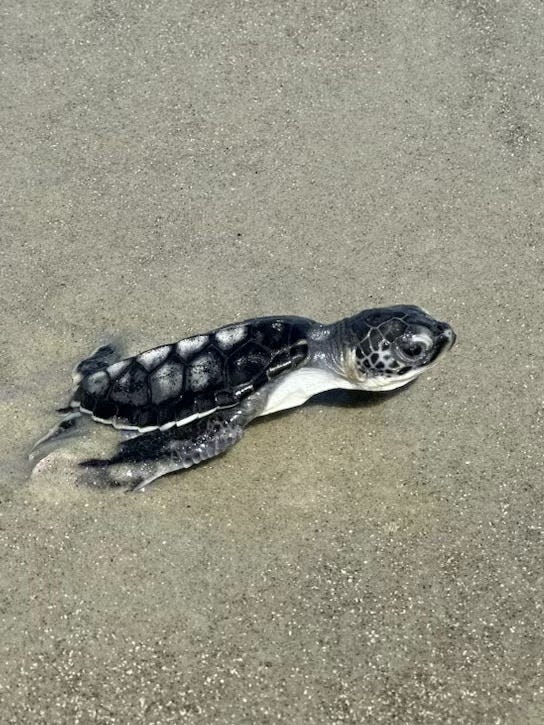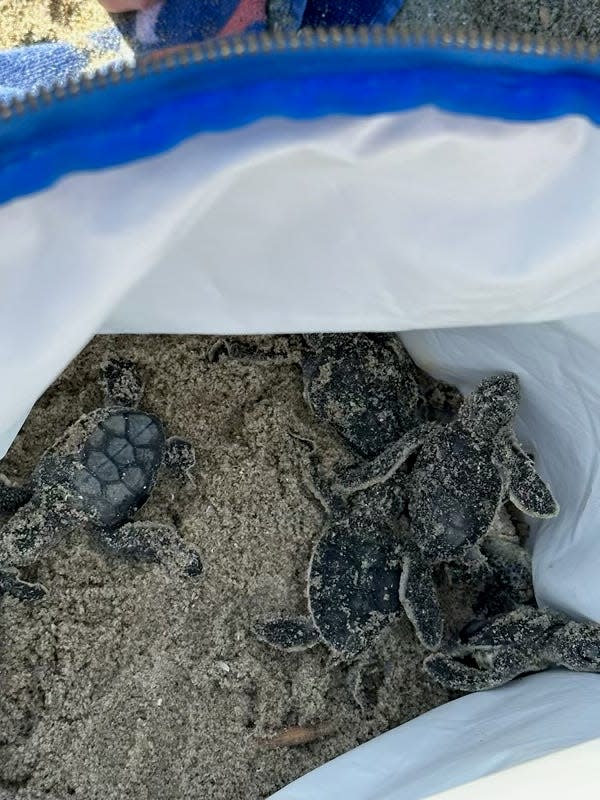Turtle Tracks: A rare green sea turtle nest found on Tybee Island

Earlier this week, volunteers at the Tybee Island Marine Science Center inventoried a nest of sea turtles like they have done many times since the beginning of May, when the Georgia coast's annual sea turtle nesting season commenced. However, this nest was a bit different from the other 31 nests, which held the eggs of loggerheads.
Chantal Audran, executive director of the center, said that they call them their "hometown girls" because 99.8% of Tybee's nest are made by loggerhead sea turtles.
This one nest, however, held green sea turtles.
Audran and her team noticed immediately that it was a different type of turtle, Audran said, because they are so used to loggerheads. "I've been in the field for 20 years, and I've never seen a green sea turtle hatchling."
Audran explained how the turtles get their name. "They eat a lot of algae, all of that chlorophyll dyes their soft membranes, so around their eyes and in other places their fatty tissues green, so we know he was a green sea turtle immediately because even the babies look really different. They have much more almondy eyes, and he was gray almost, and we're used to black, and dark brown loggerheads. I've only raised loggerheads myself, so when you hold that animal in your hand, you're immediately like, oh, this is not one."
She added, "That's why the green sea turtle was so exciting, and such a big fun surprise, we've had very few in our past."
Green sea turtles are one of five of the most common species of sea turtles found on Georgia's barrier islands. The others are loggerheads, leatherbacks, Kemp's ridley and hawksbills, with loggerheads being the most prevalent. Green sea turtles don't often nest on Tybee's beaches, however, but Audran said their appearance isn't necessarily indicative of anything.
"Sea turtles like to go back to nest on the same beach that they're born on," Audran said. "Or they will go back to the same spot they've been nesting, so it's irregular to see a neophyte, as we call them, come to our beach."
More: Here’s how many eggs sea turtles laid on Georgia beaches this year
More: Georgia's record breaking sea turtle nesting season winds to a close
More: Summertime dredging in Georgia threatens sea turtles; Corps allowed to kill 214 loggerheads

Sea turtle season
Every year at the beginning of May, Tybee Island Sea Turtle volunteers walk the beach every morning, looking for turtle tracks. Once the tracks are found, the nest is located and marked.
"We know when they're going to hatch, so we let them naturally hatch," Audran said. "We don't involve ourselves in that process. What we do, though, is five days after it naturally hatches, we go back and excavate that nest. We're going to take everything out of that two-foot hole, and count the number of hatched eggs, unhatched eggs, and how many stragglers, and sometimes there's dead stragglers; sometimes there's no stragglers."
A mother sea turtle will drop between 100 and 125 eggs, usually at night, then return to the sea. Stragglers are baby turtles that don't get out of the nest and into the water. Out of that range, 10 green sea turtles straggled behind out of the most recent nest.
After the volunteers inventory the nest, they take them down into the shoreline and release them.
"All of those 10 stragglers are released back into the ocean, but it's really a great moment to be able to see another species," Audran said.
The science center raises one straggler to be its marine debris ambassador for three years. Although they are currently shopping for a new one since their current ambassador, Ike, is due to be released Sept. 23, they couldn't keep any of the green sea turtles.
"We keep loggerheads because they are threatened in our state, but they're not endangered," Audran said. "Georgia has a lot of great numbers of loggerheads, but green sea turtles are endangered."
Caswell Beach in North Carolina also recorded its first green sea turtle nest this year. Theresea Putman, one of the co-coordinators of the Caswell Beach Turtle Watch, said she didn't really know why it happened. Caswell also normally has majority loggerheads.
"Other than population growing, the weather, climate change may have something to do with it," Putnam said. "I'm not really sure. As far as we know it's the first green sea nest Caswell has ever had."
Destini Ambus is the general assignment reporter for Savannah Morning News. You can reach her at daubus@gannett.com.
This article originally appeared on Savannah Morning News: Tybee Island Marine Science Center records rare green sea turtle nest
